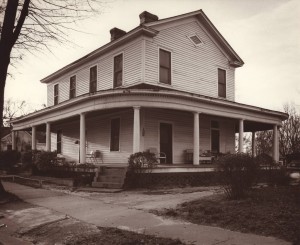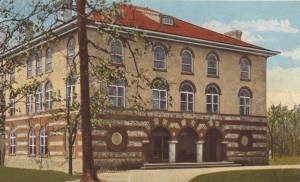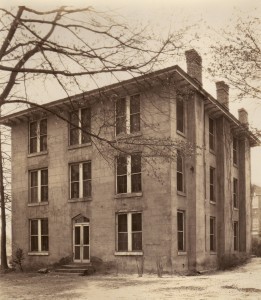Campus Housing at Presbyterian College, Part 1
August 2011
For many years the norm for campus housing at most colleges was one smallish room with at least one roommate and a bathroom down the hall shared with dozens of others. Students today, at Presbyterian College and on most other college campuses, have housing options that would have amazed the students of just a few decades ago, such as the single rooms of Senior Hall or the apartments of the Townhouses. So much has changed in a relatively short time that we thought that an overview of campus housing through the years might be interesting.

Academy Building formerly located in downtown Clinton near the present day US Post Office
When Clinton College (as PC was originally called) first opened in 1880, the “college family” was a special feature of the college. Students boarded in the lone college building, a white frame structure located near the center of town on Academy Street, under the charge of Professor William States Lee, PC’s first president and, for the first several years, its sole faculty member. PC’s first residential students were primarily the sons of Dr. Lee’s personal friends. Women were also accepted as students at PC, but they attended as day students; most were daughters of local families, but a few female students came from out of town and boarded with local residents. Total college costs for students boarding with Dr. Lee were $100 per year.

Recitation Hall formerly located on the campus of Thornwell Orphanage
The first building constructed expressly for the college was Recitation Hall, which was built on the Thornwell Orphanage campus and was partially in use by 1886. The building is described in the 1888-89 PC catalogue: “The first story is occupied by the President’s family, thus giving a home-like aspect to the College. College Classes occupy the second story. The Assembly Hall and the Primary and Preparatory departments, fill the third floor. The fourth is to be used for a Museum and Library.” Presumably at that time the “College family” model was still in effect and some students resided on the first floor with Professor Lee and his family.

Alumni Hall c. 1938
Alumni Hall, PC’s first true dormitory and the first building to be built on the present campus, was built in 1891. A small frame dining hall/kitchen was built the same year; meals were provided for $6 per month. In 1892, the Cottage Dormitory (also called a professor’s cottage), which offered student and faculty accommodations for 14, was built. By this time PC was moving away from the “College family” living arrangement and toward more traditional dormitories.
Despite these changes, in some ways perhaps things aren’t as different as we tend to think they are. For example, although we may think of damage to college property caused by students as a problem of fairly recent origin, the 1892-93 PC catalogue notes that “all damage done to furniture will be charged to occupants of rooms.” The 1898-99 catalogue notes that students are liable for “damage done to furniture or buildings,” perhaps indicating that vandalism was becoming more of a problem. Then the 1901-02 catalogue notes that students’ rooms are not furnished, adding that the college had a small number of needed items (washstand, bureau, table and chairs, bed, and springs and mattress) available for purchase.
Apparently parents and prospective students continued to inquire about whether dormitory rooms were furnished. In response to these questions, the 1921-22 catalogue states, “Years ago the College furnished the students’ rooms, but they abused the furniture to such an extent and broke up so much of it that the policy had to be abandoned.” However, by the 1923-24 academic year, the catalogue again indicates that dorm rooms are furnished and includes the text of a room contract each dorm resident is required to sign assuming liability for any damages.
We’ll continue our look at campus housing in October.
